#AdvancedResearchMethods
Explore tagged Tumblr posts
Text
First meeting of presentation group:
I thought I was well prepared, but I had missed the real learning behind which was to collaborate with other students! I did not feel confident in the ideas that I was bringing to the meeting, as I found the theoretical concepts interesting but I felt I only just understood them myself, as soon as somebody asked me to explain the concepts even when I tried, I could see that I had not made myself understood, and in no way had I sparked a glimmer of interest :) I had worked quite hard to get the information together, but on reflection I would have been better off trying to make contact with the other students in the group. As our lecturer pointed out, how can we cover the subject of philosophy as method with four individuals each doing five minuites. In the meeting I found myself far more interested in her ideas about Arthur Schopenhauen and Joseph Campbell then my own ideas. I suppose this is what makes collaboration interesting.
We decided to divide the presentation up into: Schopenhauer; Joseph Campbell; Artists/Pictures; Paul Graham.
We had a not of discussion about the order...we started with Schopenhauer, but a group member felt that it was very important to start with context first. I need to read up on Schopenhauer, Campbell and Graham and am hoping I will have a better understanding of why it is important to start with context.
My five minuites is about looking at artists/pictures using philosophy as research....Schopenhauer, Campbell, Graham
3 notes
·
View notes
Text
Feast for the Eyes - Exhibition - Advanced Research Methods
30th October 2019 - The Photographers’ Gallery
The second exhibition on when visitied the photographers’ Gallery, was Feast for the Eyes - The Story of Food Photography which broadly explored the history of food photography. There were a wide variety of work from different photographers such as Stephen Shore, Guy Bourdin, Hank Willis Thomas or even Russell Lee.
Again, I think any kind of methodology could be used while analysing this work. It might depends from images on their own than when looking at the whole body of work. But after rereading what I wrote about the exhibition, I think I unconsciously used a photographic theory kind of approach.
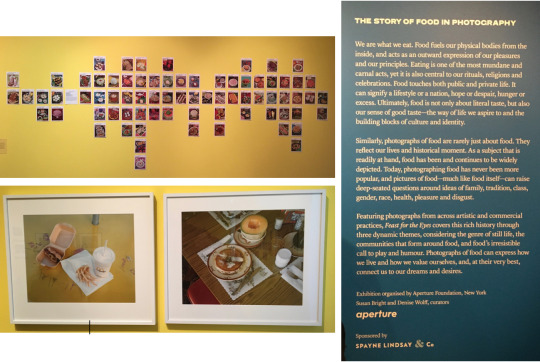
For example, the two images from Stephen Shore above could be analysed by looking at the history of still life. Why did he photograph them this way, what does it mean. We’ve learned in the past that whether it was painting or photography, the use of “rare” aliments was a way to show how wealthy people were. For example in one of the photo further below dated from the 1850′s from photographer Roger Fenton, we can find a pineapple which was quite a rare fruit to get at the time, it highlights a certain wealth that we can’t really see on, for example, Shore’s image above of a fast food meal.
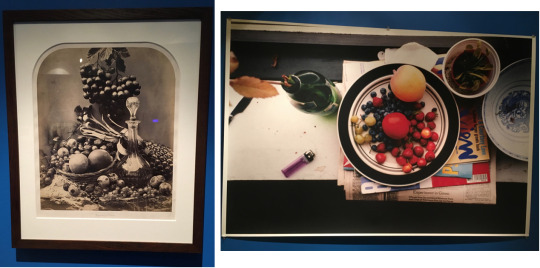
Roger Fenton, Decanter and Fruit, ca. 1853-60 (left) Wolfgang Tillmans, Summer Still Life, (right)
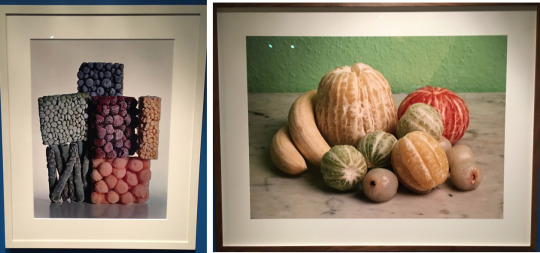
Irving Penn, Frozen Foods, 1977 (left) Holger Niehaus, Untitled, 2000 (right)
The two images above reminded me of something that Walter Benjamin wrote in his article about the book of Karl Blossfeldt on plant photography (Artforms in Nature) and how Blossfeldt’s images were a new way to perceive the world. In a way we rarely look at fruits and vegetable this way. Penn and Niehaus, both, showed us a different way to look at those elements, a way that we have never really looked at before.
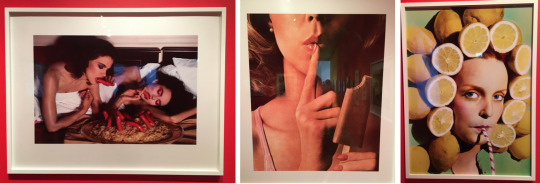
Guy Bourdin, Vogue Paris, September 1981 Hank Willis Thomas, You’ll Never Guess Our Deep, Dark, Delicious Secret, 1984/2015
We could also find a lot of fashion and commercial images in the exhibition which was to me very unexpected but not out of theme. It was actually fascinating how disturbing some of them were such as the one from Guy Bourdin (above, left) of the two models eating sausages.
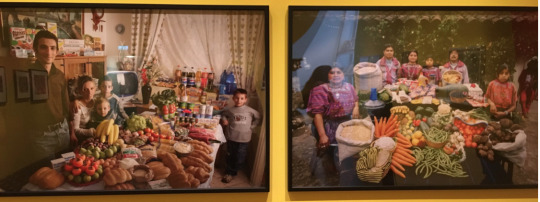
We could also find some more documentary directed kind of work such as the two images above from photographer Peter Menzel who photographed what families eat for a certain amount of time. It highlights how different our alimentation is depending on our culture and wealth.
Another quite interesting documentary images showed, was the images from Russell Lee expressing a rather harsh reality after the War.
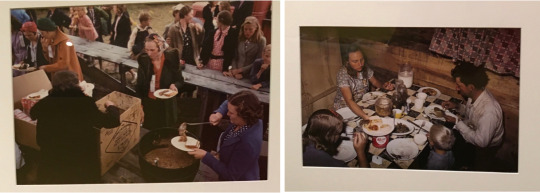
1 note
·
View note
Text
Shape of Light Exhibition, Tate Modern
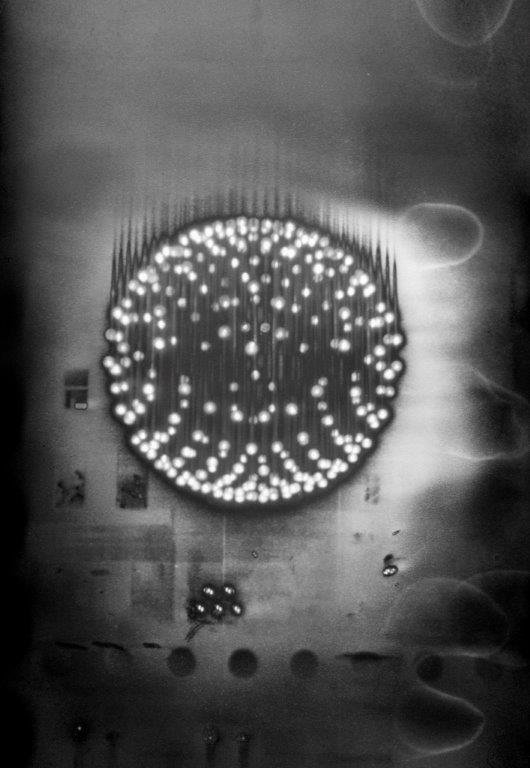
This was one of the most inspiring exhibitions I had been to in quite a while, this exhibition has really opened my eyes to new ways of executing photographic methods. I had recently been questioning what photography is to me and how it can be considered a skill or how photographers can be considered as talented as a painter perhaps, but this exhibition with all these beautiful and unique abstract forms of photography has really inspired me to try quite literally everything I’ve seen here, I came for inspiration for one project and left with several.
An artist who really stuck our for me was Peter Keetman, who had a series entitled, ‘Light Pendulum Oscillation’, an intricate and somehow almost mechanic dance of light exposed into a crisp photograph. A significant part of this series is the contrast with the more concentrated pieces of light creating some incredibly bright eye-catching areas and some equally beautiful faded and spaced out, creating mysterious almost murmuration-esque patterns.
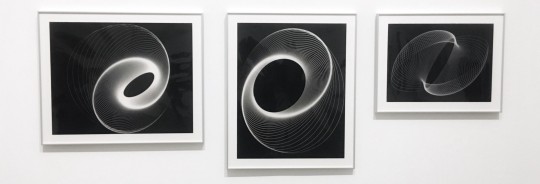
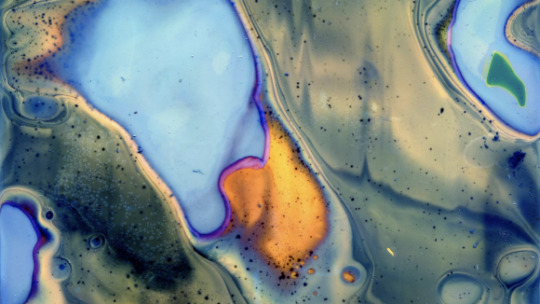
Another incredibly beautiful form of abstract photography that I found was the use of chemigraphs, these create incredibly abstract and beautifully coloured and ironically fluid flowing images. The creation of chemigraphs brought together two different artistic forms of painting and photography, the chemigraphs presented within the exhibition are used without a camera (so I suppose does this still class as photography or is it painting with chemicals or just another medium altogether?) they are created through using photographic chemicals on light sensitive photopaper. The outcomes are entirely unique although different effects can be achieved by changing the light that hits the paper or many artists have used materials such as wax, polish or varnish to block chemical reactions, creating the most beautiful and unexpected abstract ‘photographs’.
2 notes
·
View notes
Link
Advanced Research Methods: Week 1 Intro Re-cap
Methods & Methodologies for analysing images
#advanced research methods#arm#bapa2#week1#advancedresearchmethods#methods#methodologies#gender theory#art theory#5IMAG016W.1
1 note
·
View note
Text
Photography is a black hole
I was thinking that, in a way, the act of taking a picture consists in resizing reality in a bi-dimensional surface. It is almost as if the camera operated as a black hole: it absorbs and swallows every single detail of what is in front of us and it transforms the latter in a pure abstraction.
2 notes
·
View notes
Text
Seminar Presentation 1
Seminar Presentation 1 - Conceptual Photography
13/11/2019
Following the presentation workshop we had with Neil, I and my group have made some points related to the method we are going to discuss during our seminar next week.
The method we have chosen to use is Art Theory/History and we are going to explore Conceptual Art as ART MOVEMENT.
One of us is going to do an Introduction and Conclusion talking about the 3 characteristics of Conceptual Art: anti-aesthetic, anti-technical, anti-establishment.
Therefore, each one of us is going to discuss an artist’s piece made during the “conceptual art period”.
I will be discussing the photograph below: Self Burial ( television Interference Project 1969 by Keith Artnatt )

Details Below:

UPDATE: presentation done, it was actually fun!
I and my group we had previously met and decided that Ozzi was going to do the introduction and the end and I, Roberta and Lucrezia were going to discuss one image each and in the end, we played a fun video by Baldassari.
Ozzie explained what the conceptual art movement was and did an intro about what we were going to discuss. After we examined the images (anti-technical, anti-aesthetic and anti-establishment / anti-art.) I think it was the perfect way to do it, considering that we had such a small amount of time to prepare it and to talk about during the seminar ( 5 minutes each)
I really loved this task as all the members of my group brought an idea that we then combined together, also Roberta’s idea to bring the video at the end was perfect as it broke a bit the ice and tension in the room,
Video by John Baldassari (below) source: youtube
youtube
Although I wrote my previous essay about conceptual art, it was nice to go back and read about it again, also I have learned about other artists as those we have talked about are not the same I wrote about in my essay,
If I could go back I would have loved to talk to the class a bit more and discuss conceptual art and also I would not want to read it out from a sheet of paper :)
I am not sure that this will help me in regard of what I am writing about in my essay, but certainly, it has helped me to build some confidence in terms of talking in front of other people as well as working in a group, sharing ideas, finding compromises and working together with deadlines!
0 notes
Text
Advanced Research Methods Final Journal
In the first day of May in 2019, I finished writing my essay. For this essay I have used the following books and periodicals:
Bajac, Q. and Berktay, A., 2002. The invention of photography. Harry N. Abrams.
Barrett, E.& Bolt, B. (2009). Practice as Research: Approaches to Creative Arts Enquiry, I.B. Taurus.
Batchen, G., 2002. Each wild idea: writing, photography, history. MIT, Press. Blaxter, L., Hughes, C. and Tight, M. (2010). How to research. Open UniversityPress.
Burns, T. (2012). Essential study Skills, Sage. (3rd. Ed.)
Buzan, T. (2006). Study Skills Handbook, BBC.U. K, Rout ledge. Carter, P. (2004). Material Thinking. Melbourne University Press.
Chéroux, C., Apraxine, P., Fischer, A., Canguilhem, D. and Schmitt, S., 2005. The perfect medium: photography and the occult. Yale University Press.
Cottrell, S. (2011). Critical Thinking Skills. Palgrave, Macmillan. D’Alleve, A. (2012). Methods and theories of art history, (2nd ed.), Laurence King.
Eigen, E., 2001. Dark space and the early days of photography as a medium. Grey Room, pp.90-111.
Gassan, A., 1972. A chronology of photography; a critical survey of the history of photography as a medium of art. Handbook Co. distributed by Light Impressions, Rochester, NY.
Gray, C. & Malins, J. (2004). Locating and using reference materials for art and design research. In visualizing research: a guide to research process in art and design. Ashgate.
Green, D. and Lowry, J., 2009. Photography, cinema and medium as social practice.Visual Studies, 24(2), pp.132-142.
Greentham, B. (2008). How to write Better Essays. Palgrave, Macmillan. (2nd Ed.). Grix, J. (2010). The foundations of Research, Palgrave/Macmillan, (2nd Ed.). Krauss, R.E., 1999. Reinventing the medium. Critical Inquiry, 25(2), pp.289-305.
Marsh, A. and Stacey, R., 2010. Six photographs published in Look Contemporary
Australian Photography since 1980. Rumsey, S. (2008). How to Find Information: a guide for researchers, OUP
(electronic resource), (2nd Ed).
Vescia, M., 2014. Depression glass: documentary photography and the medium of the camera-eye in Charles Reznikoff, George Oppen, and William Carlos Williams. Rout ledge.
Wells, L., 2015. Photography: a critical introduction. Rout ledge.
I am very nervous for the results of the E-journal, after all, my status is “referred” at moment. I hope I can pass this module, furthermore I believe I can do much better next year.
0 notes
Text
Advanced Research Methods: Group Seminar Powerpoint Side Notes (Part 2).
26.11.2018







These are our side notes that we used to elaborate on each slide, to add more detail and depth into our group presentation. My section was the Civil Rights Movement and its consequences.
#5IMAG016W#AdvancedResearchMethods#UniversityOfWestminster#AdvancedMethods#GroupSeminar#JournalTask#BAPhotography
0 notes
Photo







Gallery write up: task 5
We visited the Thomas Ruff exhibition at the Whitechapel gallery, we can analyse his work in terms of history and technologies. Throughout the exhibition we see the use of technology in all ways, changing depending on the time period. His most famous work are the large portraits, deemed anti portraits as they don’t show anything to the character or personality of the sitter. These portraits, as with the rest of the exhibition, are an example of the limits of technology. It was a fascinating visit, as you learn that technology cannot tell the soul of a person no matter how good the camera is, and it cannot show you all the stars in the sky only a portion.
We can consider Ruff’s body of work with historical, portraiture and identity, and social methodologies, for instance in the 3rd and 4th photos above. In this work Ruff uses found photography documenting various terrorist attacks and disasters, the pieces having been found at low resolution on the internet. He then blew up the photograph so that, when displayed, we see all the pixels and imperfections in the photograph. When we consider it historically we think of the evolution of technology in capturing these events and then showing them to the public. With the internet people can be informed on these events minute by minute, however in Ruff’s work we can see that technology still cannot replace the human experience of being there and seeing it for yourself.
Similar to the large portraits in which we can see huge amounts of detail in the faces of the people, but cannot actually know the character of the person in them. We can use portraiture to analyse this work, looking at how other artists use expression and lighting and scene setting to convey the character of their sitter, and the complete lack of therefore in Ruff’s work.
0 notes
Text
Seiichi Furuya
Seiichi Furuya: ‘Graz’, 1979
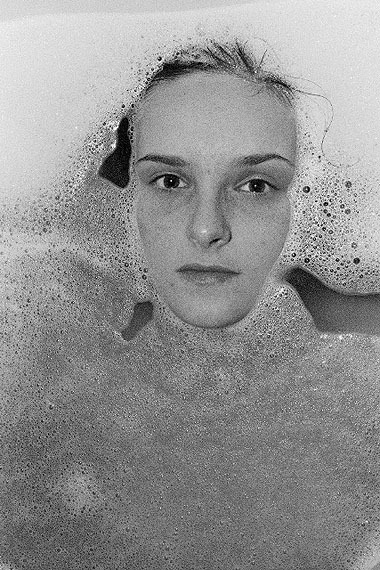
In a simple, yet striking portrait, Seiichi Furuya pays tribute to the phrase, “there is always more to someone than meets the eye.” Through both visual metaphor and compositional structure, the photo titled Graz muses on the idea that a person’s beauty may conceal what they are feeling or thinking. Humans are, after all, a sum of paradoxes, who have flaws contained within beauty, and who do not always share on their face what may be lingering beneath the surface.
I first saw this portrait at SFMOMA and was immediately drawn to it. We see a woman’s face staring directly into the camera, her body obscured by bath water. Her expression is calm and yet her slightly raised eyebrow suggests something is being hidden. Perhaps, a joke is being shared between her and the photographer?
Whether intentional or not, the water becomes a blurred surface, shades of grey and white that allow the viewer to focus solely on the intricacies of this woman’s expression. Indeed, the subject’s close proximity to the lens, the implied bathroom setting, and her direct eye contact make us wonder what could have created the context for such an image. It is an incredibly intimate portrait.
Further research[1][2] reveals that Graz is a photograph of the artist’s wife. Christine Gössler met Furuya in 1978. She lived in Austria with her husband, and in 1985, she committed suicide. This portrait was taken only a few years before her death and the knowledge of that event casts a melancholy shadow over the beauty of the image. Looking again at the portrait, is there a veil of sadness over her eyes? Is she emerging or retreating? What is lingering beneath the surface of that gaze?
The photo becomes that much more rich as Furuya sets up the visual metaphor of a face emerging from the surface of water, while the rest of the body is obscured. Initially, we bear witness to an intimate moment between husband and wife, but ultimately we are seeing a woman whose story would soon change dramatically.
Much of Furuya’s work revolves around his wife. There is a curiosity, care, and respect for her that permeates his practice. In a descriptive piece on the photographer, the Metropolitan Museum writes, “Like a writer mulling over his material, Furuya coaxes clues out of the unanswerable questions of human suffering and experience.”
Naturally, Furuya uses his talent and skill as a photographer to make sense of his marriage and his wife’s condition. In his oeuvre, he pays tribute to Christine’s life and her beauty. In the end, his portrait, and all portraiture, is a tool for understanding humanity. Our flaws, our beauty, and our individuality all contained within a figure or expression frozen in time.
While not incredibly well known, Seiichi Furuya’s work is a worthy addition to the canon of photographic portraits taken in the 20th century.
2 notes
·
View notes
Text
Presentation - Group exercise - Advanced Research Methods - Psychoanalysis
20th November 2019
After choosing the method of psychoanalysis for the group presentation, I was put into a group with two other people (Miro and Tanya) with who we decided for each one of us to explore a topic of our choice link to the chosen method. After long deliberation and many changes in example, I decided to look at part of Carl Jung’s theory on the personal and collective unconscious. Tanya concentrated more on Sigmund Freud’s theory using an example of her choice while Miro had a mix of both Jung and Freud’s theories using the example of William Klein’s work on New York and Antoine D’agata’s series entitled Antibodies from 2014.
Freud’s ‘Unconscious Mind’ Theory:
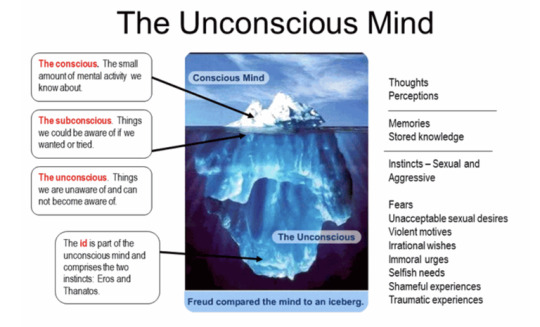

Personal Unconscious
Events or feelings that we were conscious of at some point but were slowly forgotten or repressed over time.
Senses and impressions which were never really strong enough to reach our consciousness.
Childhood memories
Feelings
Could also be something like even just a smell that we attribute unconsciously to a person or an events.
We can probably find it in anyone’s work. Whether as creator (photographer/artist) or viewers.
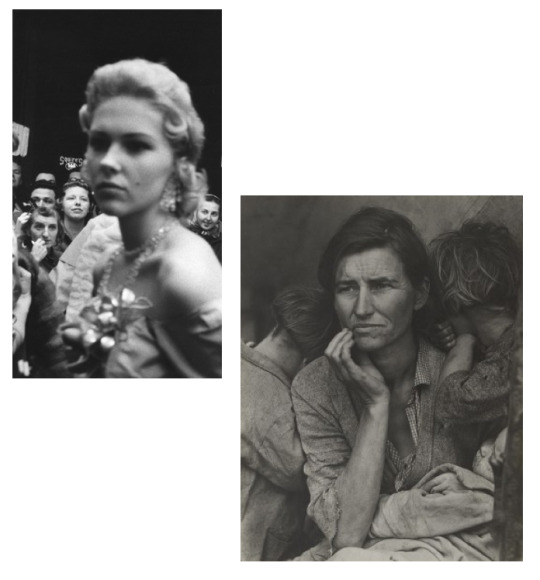
Robert Frank, The Americans: Blurry beautiful girl (actress) at a movie premiere. what is in focused? The other woman at the back -> The other women at the back, admiring, looking at her. We could almost he missed his shot.
Women looking at women -> Could it be envies? Was it really the photographer’s intentions?
What does it say about the viewer?
The Collective Unconscious
Contents common to everyone. “The collective unconscious, however, as the ancestral heritage of possibilities of representation, is not individual but common to all men, and perhaps even to all animals, and is the true bassist's of the individual psyche.” C. Jung, “The Essential Jung”, pp. 67
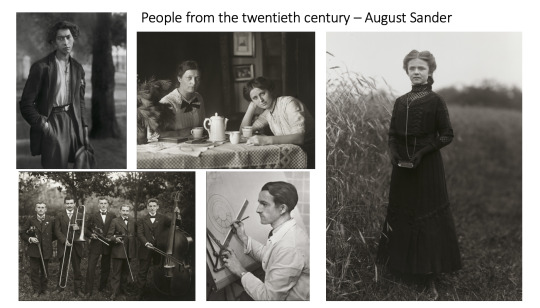
People from the twentieth Century by August Sander
French Philosopher Louis Althusser talked about the topic as Ideology and it was communicated through “images, myths ideas or concept” (Bate, 2009, p30)
Sander intended to create a “comprehensive cultural history and social analysis in pictures” of German people (the way Claudia Bohn-Spector puts it) by creating a collective portrait of German society during the Weimar era (Germany’s government from 1919 to 1933) trying to outline the existing social order.
We can feel a sense of conventionality in Sander’s image. Not only esthetically but also in the way he might have thought of society and maybe even how most people were picturing Society at that time. Another sign very noticeable is the chosen order of the presentation of his work: presented from a scientific point of view, arranged in 7 groups, published in 45 albums of approximately 12 images. Starting from the bottom (lower class) going all the way up and down again, ending his work with the sick, disable and dead. Often separating men and woman (unless it was a family photo). He apparently did it as an immediate observation. (that’s what the editor said) -> he followed his instinct.
A representation of what society thought of each other at that time.
The subject that I chose is link to my essay, this is mainly why I went on that road. Something I know for sure that I forgot at the end of my presentation was the references. I had them in my notebook but didn’t but them on the presentation and I noticed that everybody else had theirs on their presentation.
0 notes
Photo

0 notes
Link
#5IMAG016W#advanced research methods#advancedresearchmethods#Journal Task#JournalTask#btf#arm#5IMAG016W.1#5imag001w.1#5imag001#5IMAG016
0 notes
Photo

This portrait has been made by positioning the camera on the top of the tripod, pointing downwards. I’d like to analyse it from a philosophical point of view. Ontologically, it is the result of photons being registered by the digital camera’s sensor. Lately I am a bit confused on whether digital photography can actually be considered photography, but that’s not the point of the brief discussion.
I think that from an ethical point of view, the picture is a portrait and a self portrait at the same time, and both the subjects were aware of this. Therefore, it is not unethical.
Aesthetically, the picture is making me think about the use of the black and white. I was reading “Towards a Philosophy of Photography, by Flusser, and he argues that the purest form of photography is black and white photography, in that colour photography implies another form of abstraction from the real: the colours cannot actually be reproduced on film.
I like this picture as it raises questions about the identity of the two subjects, the position of the woman on a relatively higher point compared with the man. The triangles that can be observed by looking at the position of the woman’s arms is linked with the man’s eyes.
#photography#inspiration#myphotography#selfportrait#philosophy of photography#flusser#5IMAG016W#advancedresearchmethods#further research
2 notes
·
View notes
Text
Advanced Research Method 6
30/10/2019
ADVANCED RESEARCH METHODS
Week 6: Gallery Visit 2
Blog task: Write a reflection on what you saw today. Which methodologies could you use to analyse images from the exhibitions?
The first exhibition we saw today at the Photographer's Gallery is called “Feast for the Eyes - The Story of Food Photography” and it traces the history of food photography ( photographed by important and leading artists), the idea that “we are what we eat”, as well as exploring the artistic, social and political context by using forms of fine art, fashion photography, journalism, and advertising.
The exhibition featured work from : Guy Bordin (representing it in fashion style), William Eggleston, Cindy Sherman ( using her “putrid” style), Tim Walker, Laura Letinksy ( using her soft “still life” style), and many others, among which my favourite Lorenzo Vitturii, Photo-sculpture Pink #1 from the Dalston Anatomy series, 2013. ( picture below)

His work, for example, could be analysed from an Art Theory as well as Globalization Theory since what he represent is a visual celebration of the Ridley Road Market in East London in which he recognises the market as a unique place where ‘different cultures merge together in a celebration of life, diversity and unstoppable energy’ and was inspired to capture this place before it transformed beyond recognition. The objects in these photographs are taken from the market itself, he leaves them to rot to then reconstruct them into these statues. These reconstructions in the exhibition space reflect on constant cycles of production, destruction, and recreation. (Here we see the Art Theory and Globalization)
The other part of the exhibition at the Photographer’s Gallery was “Shot in Soho” and it portraited the vibrant area that has been ( and still is ) the hub for LGBTQ+ communities, movie-set, sex shops, bar, cabaret, spectacles, music, fashion design and more...

(Kelvin Brodie for The Sunday Times Magazine, 1968 © Times Newspapers Ltd - the image above )
This image could be analysed through Gender methodology as the whole exhibition CELEBRATES this diversity, creativity, and transformation, featuring works from William Klein, Anders Petersen, Corinne day, Kelvin Brodie, and many more. In my opinion, it can be analysed mostly from a History Theory as the main concept is to capture the change and transformation of the community through the years, drawing on the history, the myths, and the characters ( such as punk movement), eccentricity and communities. Also, it can be analyzed from a Globalization method as the area is facing a radical development and these are images of places that might be disappearing due to the transformation the area is going through. “The imminent completion of Cross Rail (a major transport hub being built on Soho’s borders) in Autumn 2019, makes the area a prime target for development and threatens its existence as a place of unorthodoxy and independence.” (Photographer's gallery)
0 notes
Photo





Week 6: Gallery Visit
“Performing For The Camera”
I came to the Tate Modern to visited an exhibition, the name is “Performing For The Camera”. The topic of this exhibition is talk about the relationship between photography and performance, from the invention of the photographic media in the nineteenth century to digital cameras and social media. The exhibition brings together photography made to document performances by artists, actors and dancers, With works made by artists who use the camera as a tool of produce their own performative images. It encompasses serious works of art that deal with identity politics, carefully constructed fantasies, and with improvisational snapshots.
The photographic image went on to become an arena within which to act, distinct from the live stage of theatrical or artistic performance, in works by artists like Charles Ray, Carolee Schneemann and Erwin Wurm. These artists often perform for their own cameras, either physically as in Paul McCarthy’s Face Painting – Floor, White Line 1972 or more conceptually through ideas of self-image and fantasy as in the work of Boris Mikhailov. The construction of self-identity and posing is explored through iconic works by Claude Cahun, Man Ray and Cindy Sherman, as well as more recent projects like Samuel Fosso’s African Spirits 2008, in which the artist photographs himself in the guise of iconic figures like Martin Luther King Jr and Miles Davis. The world of social media is addressed in a key recent work staged on Instagram by Amalia Ulman. The exhibition shows not only that photography has always been performative, but that much performance art is inherently photographic.
0 notes